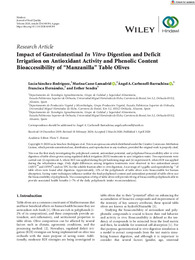Por favor, use este identificador para citar o enlazar este ítem:
https://hdl.handle.net/11000/38459Registro completo de metadatos
| Campo DC | Valor | Lengua/Idioma |
|---|---|---|
| dc.contributor.author | Sánchez-Rodríguez, Lucía | - |
| dc.contributor.author | Cano-Lamadrid, Marina | - |
| dc.contributor.author | Carbonell-Barrachina, Ángel A. | - |
| dc.contributor.author | Fernández, Francisca | - |
| dc.contributor.author | Sendra, Esther | - |
| dc.contributor.other | Departamentos de la UMH::Tecnología Agroalimentaria | es_ES |
| dc.date.accessioned | 2025-11-24T17:16:01Z | - |
| dc.date.available | 2025-11-24T17:16:01Z | - |
| dc.date.created | 2020 | - |
| dc.identifier.citation | Journal of Food Quality Volume 2020, Article ID 6348194 | es_ES |
| dc.identifier.issn | 1745-4557 | - |
| dc.identifier.issn | 0146-9428 | - |
| dc.identifier.uri | https://hdl.handle.net/11000/38459 | - |
| dc.description.abstract | This was the first study investigating the polyphenol content, antioxidant potential, and polyphenol bioaccessibility after in vitrodigestion of table olives grown using regulated deficit irrigation (RDI) treatments to save irrigation water. Two experiments werecarried out: (i) experiment A, where RDI was applied during the pit hardening stage and (ii) experiment B, where RDI was appliedduring the rehydration stage. Only slight differences among irrigation treatments were observed in two antioxidant assays(ABTS +• and DPPH•) and on TPC for the soluble fraction after in vitro digestion. An average of 1 g gallic acid equivalents kg− 1 oftable olives were found after digestion. Approximately, 12% of the polyphenols of table olives were bioaccessible for humanabsorption. Saving water techniques influence neither the final polyphenol content and antioxidant potential of table olives northe bioaccessibility of polyphenols. -e consumption of 40 g of table olives will provide 40 mg of bioaccessible polyphenols able toprovide associated health benefits (∼7% of the daily polyphenols intake recommendation) | es_ES |
| dc.format | application/pdf | es_ES |
| dc.format.extent | 6 | es_ES |
| dc.language.iso | eng | es_ES |
| dc.publisher | Wiley Hindawi | es_ES |
| dc.rights | info:eu-repo/semantics/openAccess | es_ES |
| dc.rights | Attribution-NonCommercial-NoDerivatives 4.0 Internacional | * |
| dc.rights.uri | http://creativecommons.org/licenses/by-nc-nd/4.0/ | * |
| dc.title | Impact of Gastrointestinal In Vitro Digestion and Deficit Irrigation on Antioxidant Activity and Phenolic Content Bioaccessibility of “Manzanilla” Table Olives | es_ES |
| dc.type | info:eu-repo/semantics/article | es_ES |
| dc.relation.publisherversion | https://doi.org/10.1155/2020/6348194 | es_ES |

Ver/Abrir:
Journal of Food Quality - 2020 - Sánchez-Rodríguez - Impact of Gastrointestinal In Vitro Digestion and Deficit Irrigation.pdf
1,14 MB
Adobe PDF
Compartir:
 La licencia se describe como: Atribución-NonComercial-NoDerivada 4.0 Internacional.
La licencia se describe como: Atribución-NonComercial-NoDerivada 4.0 Internacional.
.png)